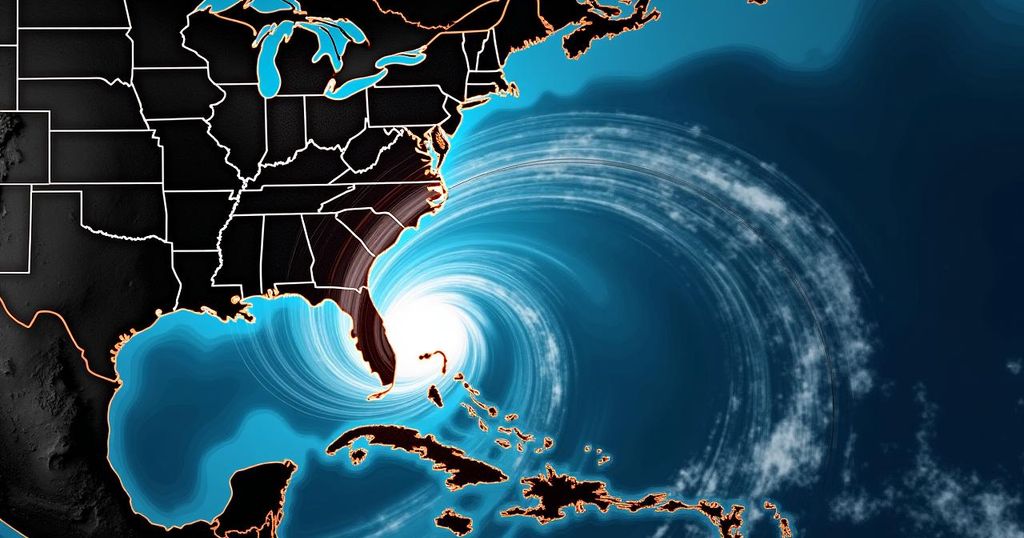Hurricane Milton Threatens Florida’s West Coast with Catastrophic Storm Surge

Hurricane Milton is rapidly intensifying into a major hurricane with predicted storm surge of up to 12 feet threatening Florida’s west coast. The National Hurricane Center has issued warnings for substantial flooding risks, especially in the Tampa Bay area. Residents are urged to prepare for potential evacuations as the storm approaches, with historical context indicating the severe dangers associated with hurricane-related storm surges.
Hurricane Milton has rapidly intensified into a major hurricane threatening Florida’s west coast just days after Hurricane Helene caused significant damage in the region. The National Hurricane Center has issued warnings of a potential storm surge reaching up to 12 feet from Venice to Tarpon Springs, which includes major cities such as Tampa, St. Petersburg, Clearwater, and Sarasota. This forecast represents the highest storm surge warning ever recorded for the Tampa Bay area. Many communities along the Sun Coast that recently experienced severe flooding from Hurricane Helene are now facing an even greater storm surge threat, nearly double in intensity. Should the eye of Hurricane Milton approach or pass north of Tampa Bay, the resulting storm surge could be the most catastrophic the area has encountered in over a century. The trajectory of Milton is crucial in predicting where the worst storm surge will impact. Small deviations of 20 to 30 miles in the storm’s path could lead to vast differences in flooding outcomes. The unpredictability of storm paths, especially along Florida’s distinctive peninsula shape, complicates accurate surge forecasting. Historically, storm surge has been the leading cause of hurricane-related fatalities, prompting precautionary evacuation orders in high-risk areas. Currently, a storm surge watch is active for the entire west coast of Florida up to Cedar Key. Residents living in low-lying coastal zones should consider evacuating just a few miles inland to avoid dangerous flooding conditions. Milton is experiencing an explosive strengthening phase and may reach Category 5 intensity by the time it makes landfall. Although it is common for hurricanes of this magnitude to occur earlier in the hurricane season, recent history has seen a scarcity of such storms developing this late into the season. The most recent occurrence was Hurricane Michael in 2018. Anticipations of continued strength from Milton exist until Tuesday, when an increase in upper-level winds is expected to influence the hurricane. Even with a potential decrease in maximum wind speed, this could result in a broader area of impact, contributing to extensive storm surge amounts as it approaches land. Heavy rainfall is expected to persist in southeastern Florida as Milton advances, with previous rain totals reaching up to 5 inches. The forecast indicates that additional rainfall will lead to increased flooding risks, particularly across the urban I-95 corridor. By mid-week, flooding threats will likely extend northward into the I-4 corridor and beyond as Milton moves inland. In addition to Hurricane Milton, the Atlantic currently observes Hurricane Leslie and Hurricane Kirk, marking a historic occurrence of three simultaneous hurricanes within the basin during October. While Leslie is anticipated to weaken over the Atlantic, Kirk appears to be losing its tropical characteristics, transitioning into an extratropical system en route to Europe.
Hurricane Milton’s rapid transformation into a major hurricane presents a severe risk to Florida, particularly affecting regions still recuperating from the impacts of Hurricane Helene. The National Hurricane Center’s storm surge forecasts predict a potentially unprecedented level of flooding, particularly in the highly populated Tampa Bay area. Understanding the dynamics of storm surge and its historical implications on communities along the coast is essential as residents prepare for possible evacuation and safety measures. The unpredictable nature of hurricanes highlights the vulnerability of coastal populations, making timely alerts and accurate forecasting critical for public safety. Furthermore, the concurrent activity of multiple hurricanes in the Atlantic during October underscores the significance of ongoing monitoring for meteorological phenomena in this region.
In summary, Hurricane Milton poses a significant threat to Florida’s west coast, with catastrophic storm surge forecasts that may surpass previous hurricane impacts. Residents should remain vigilant and prepared to evacuate as necessary, given the storm’s unpredictable path and the potential for widespread flooding. The historical context of hurricane impacts in this area serves as a critical reminder of the dangers associated with storm surges, which have resulted in numerous fatalities over the past decades. Additionally, the presence of two other hurricanes in the Atlantic reinforces the need for increased awareness and preparedness in the face of severe weather conditions during hurricane season.
Original Source: www.local10.com







